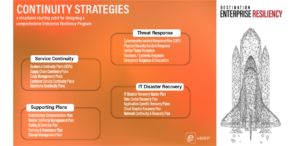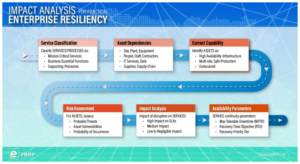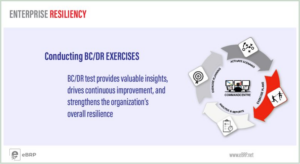In a highly regulated environment, Service Continuity Planning is essential for meeting customer SLAs and minimizing financial, reputational, and compliance impacts during disruptions.
Without a formal Continuity Planning program, 𝘪𝘯 𝘵𝘩𝘦 𝘦𝘷𝘦𝘯𝘵 𝘰𝘧 𝘴𝘮𝘢𝘭𝘭-𝘴𝘤𝘢𝘭𝘦 𝘭𝘪𝘮𝘪𝘵𝘦𝘥 𝘥𝘪𝘴𝘳𝘶𝘱𝘵𝘪𝘰𝘯𝘴, a group of Subject Matter Experts (SMEs) can be assembled to create an ad-hoc response to operational disruptions.
In larger 𝗱𝗶𝘀𝗿𝘂𝗽𝘁𝗶𝗼𝗻𝘀 𝗶𝗺𝗽𝗮𝗰𝘁𝗶𝗻𝗴 𝗺𝘂𝗹𝘁𝗶𝗽𝗹𝗲 𝘀𝗲𝗿𝘃𝗶𝗰𝗲𝘀 and dependent assets, managing the response requires identifying the appropriate continuity strategy, executing multiple continuity plans, and collaborating between diverse SMEs and stakeholders to recover numerous assets and services. This 𝗲𝗳𝗳𝗶𝗰𝗶𝗲𝗻𝘁 𝗼𝗿𝗰𝗵𝗲𝘀𝘁𝗿𝗮𝘁𝗶𝗼𝗻 𝗼𝗳 𝘁𝗵𝗲 𝗶𝗻𝗰𝗶𝗱𝗲𝗻𝘁 𝗿𝗲𝘀𝗽𝗼𝗻𝘀𝗲 is dependent on real-time situational awareness, information, and data from diverse authoritative sources.
𝗦𝗲𝗿𝘃𝗶𝗰𝗲 𝗖𝗼𝗻𝘁𝗶𝗻𝘂𝗶𝘁𝘆: 𝘈 𝘚𝘵𝘳𝘶𝘤𝘵𝘶𝘳𝘦𝘥 𝗜𝗻𝗰𝗶𝗱𝗲𝗻𝘁 𝗥𝗲𝘀𝗽𝗼𝗻𝘀𝗲 is a conceptual approach to operational disruptions. It provides a protocol that includes Incident Assessment, Responder Activation, Issue Management, and Real-Time Status Dashboards to maintain operations during unforeseen disruptions.
Having tested Service Continuity Plans builds executive confidence, ensures predictable outcomes, reduces confusion, and improves crisis response efficiency.



